In the Studio with Claude Chandler
By Sam Rietmann
The cheerful yellow door of Studio 41 on the corner of Upper Canterbury and Glynn Street is a welcome splash of colour
on a temperamental, overcast Cape Town afternoon. Slip through the door and creak up the purple wooden stairs and you
will find yourself in a diverse studio brimming with some of Cape Town’s most creative beings. One such individual is artist
Claude Chandler, former Durbanite, who has taken up residence in the mother city. We chatted about new beginnings,
studio life and his distinctive series Binary Visage.

SR: Why did you leave Durban for Cape Town?
CC: In Durban, I have this heritage. My mother was an artist and my father an artist and lecturer. I grew up in galleries so
everyone knew me, and in a way I just felt that no matter what I did there would always be that shadow. I think people always
need change in their lives, to leave the nest, go on an adventure and struggle and work. So that was why I moved to Cape Town.
It was actually quite refreshing having no one know me, being dead to the art world here, being invisible and to prove to myself
that, just on my skill alone, I can do it. And incredibly enough nearly two years later I’m becoming a full time artist.
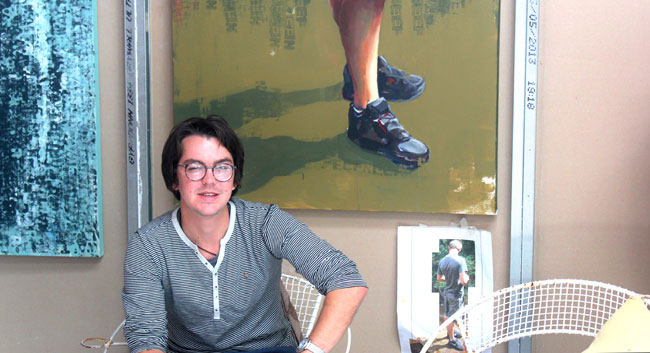
SR: Was the move to Cape Town exactly that for you, an ‘an adventure and struggle”?
CC: At the time I had moved with my girlfriend but that didn’t last long. I needed to work so it was either being a waiter or my friend,
who I was staying with, was working at Art Jamming…And you kinda got paid the same but at least you were in an art studio. I
just thought it’s so important to stay within the same genre and even though it was the lowest end of the art market. But it was cool,
like when there were no customers I could paint and use the paints for free so for a long time it worked out alright.
SR: How did you land up at Studio 41?
CC: Zavick (the founder of the studio) came to the group exhibition at Alex Hamilton, of which I was a part, and he brought three
of my works. We got chatting and he was telling me about Studio 41 and their Toilet Cubical exhibition and I was thinking ‘what the
hell, what is this’ and I took his card but I never really followed up on it. But then Adele (a fellow artist) invited me to a show here and
I just came with a whole bunch of my work. I saw Zavick and we recognised each other. We got chatting again and I fell in love with
the space….Eventually I was able to quit my job at Art Jamming and the rest is history.
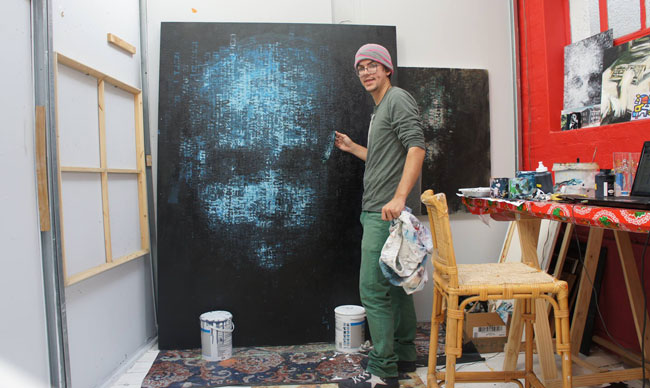
SR: What is it like working in the Studio 41?
CC: The studio gang is great; they are like my second family so we are kinda compadres. For an artist, you can work at home, but
that’s a really lonely life, very lonely career, and that blur between home life and work life is difficult. There are too many distractions,
so for me to be able to come to the studio feels like I am coming to work and then I have home time so I can separate the two lives.
I think you can get so short sighted with your work and its always great to have someone else to pull you out and give you some
criticism or some affirmation, or if I wanna take a break I can play some chess against Zavick, or have a cup of coffee with someone.
The studio means so much to me and in many regards I don’t think I would be at this stage in my career without it.

SR: Let’s talk a little about your series Binary Visage. How would you describe it?
CC: The stamps are very sort of Pop-urban, they are more open ended (than realistic portraiture). My work got labelled with this
idea of ‘Urban-Pop’ so at the moment I am sticking with it.
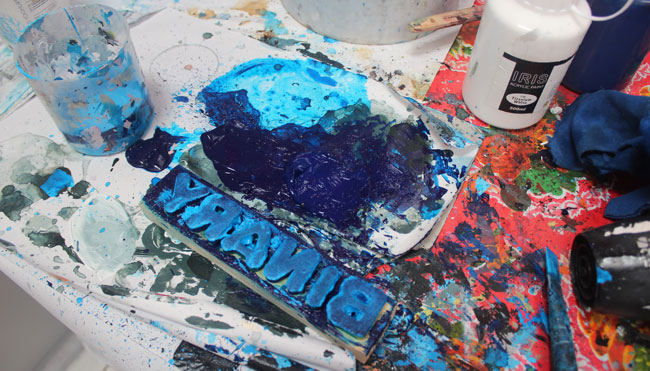
SR: How did you come across this style?
CC: The way I remember there was a group exhibition in Durban called Online at the KZN Gallery, which I was part of…I wanted
to work the surface so it looked digital, so I just did binary stamps (1’s and 0’s) with a bit of paint work as well and when it sold on
the opening night I was pretty stoked. Also in art school I was really inspired by Chuck Close and his technique, 'cause of the
relationship between abstraction and realism in his work. When you are really intimate with the work and up close, it's all about
texture or pattern or colour, and then from afar it becomes this portrait. That’s inspired a lot of my work. Being up close and
intimate, rubbing you hand on it, it’s just about texture and the print and then again from a distance it becomes resolved.
SR: Why portraiture?
I really enjoy the process of discovering the portrait, cause for me I always believe that the image is in the blank canvas and
it’s about pulling it out instead of putting it on.

SR: Some of your paintings are of celebrities and others are of ‘unknown faces’, how do you decide who to paint?
CC: Well with high school and even with art school there’s a kind of ‘who can colour in the best’ mentality. The person who
can draw more accurately is the better artist and for a lot of artists I think it is hard for them to break out of that - I faced a bit
of that with my stamp technique. The first stamps I was doing I was wanting to prove ‘ look I can make this look like Brad Pitt’
and then after a while I realised that’s not important. For me the relationship between the stamp and the face, the abstraction
and the realism, that’s what its important. The more I went away from the representational stuff, the more I found I was getting
better responses to my work. And I think its accessibility as well, maybe one out of a hundred people want to live with Brad Pitt
and one in five people want to live with ‘Binary’ or ‘Code’ or just an obscure face. That is always my issue with portraiture.
You want to be a portrait artist and for people to be able to live with your work but you want people to engage with it too.
If it is a quick representational image of somebody that they know they look and move on without fully engaging. It is always
tough to find that kind of balance
SR: How important do you believe it is to have a defined sense of style and stick with it?
CC: There is so much competition and to stand out you have to maybe be a really crazy personality but I think having an identity
in your work either, subject matter or technique, is important. Luckily for me and my technique, you see one of these and you
know ‘okay it’s a Claude’. It doesn’t disappear and that’s why I gave up quickly on realism.
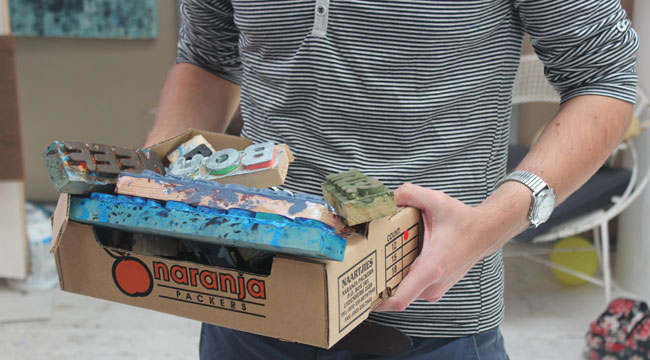
SR: Earlier on you said Chuck Close was a source of inspiration, who else?
CC: I guess Lucian Freud, Francis Bacon; huge one is Francis Bacon. He is just so honest about his work, what he did and
what he wanted to achieve. I think that is why he did what he did and why people reacted so well to his stuff. I think honesty in
your work is key and people can pick it up if you are bullshitting them. Also seeing how far you can push the boundary… I
suppose that’s why I like Damien Hirst and those guys. They do the whole looking for the boundary but there is no boundary
type of thing so I think that is important.
SR: How do you work past the dreaded artist’s block?
CC: By going to openings, and recently I downloaded a whole bunch of art documentaries. Watching them and seeing other
artist’s lives and their process and struggles, you kinda just relate to them and are like, ‘Yeah I have also been through those
things’. Also seeing the importance they attach to their work and what it’s done for their lives… it kinda ignited the fire again
for me. I just felt really great about what I was doing, about being an artist and producing work - almost like magic you know.
But I also had a period of work burn outs when I would work Monday to Sunday and after a while I realised I have to just chill
out and enjoy my life as well. SO I have been on one of those breaks at the moment, been enjoying life a bit too much
lately, but I couldn’t think of doing anything else with my life at the moment, its wonderfully fulfilling.
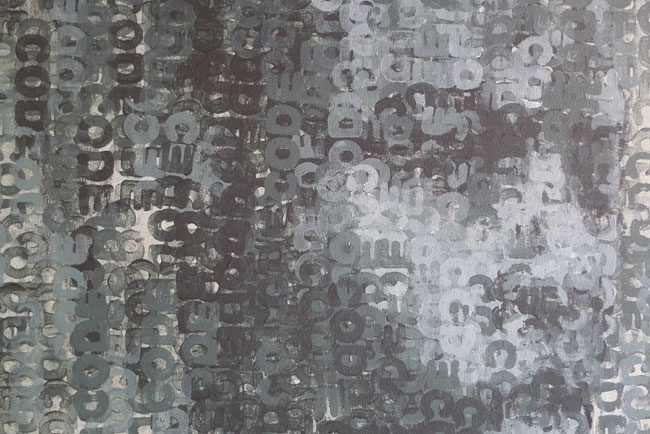
SR: Where do we find you outside of the studio?
CC: Recently I had a friend from Australia visit. I call myself a Capetonian now, and to enjoy the tourist things was good. I don’t
do that often enough anymore, so I kinda got into that again. Also then I guess Roxies, the Shack…the beach and Lions Head
now and then. I just love the fact that in Cape Town you really feel like you are trekking and in nature but then you just look
over your shoulder and there’s the city.
SR: Any advice for other artists?
CC: Anyone in the creative industry, be it artist, musician, dancer or actor, wants to be rewarded financially for their trade, and
patience is the biggest attribute needed. It’s also important for artists to get day jobs initially, because as soon as the desire to
make money penetrates your art making, you are going to start painting blomme and Karoo landscapes and all that. People can
smell that crap from a mile away. It is great having cash flow so that it doesn’t affect what you paint or how you paint. And if you
find something that works for you and you really enjoy it I think it’s best to kind of repeat and investigate it and discover things
again. Eventually there’s going to be some sort of evolutional mutation or fluke or something will happen and then you can take it further.
View Claude's Portfolio

